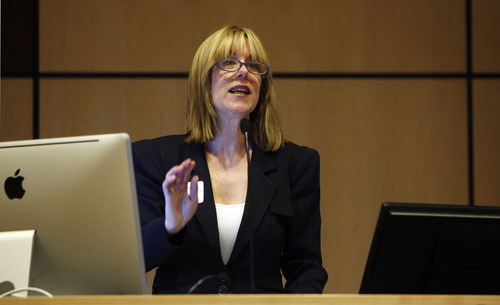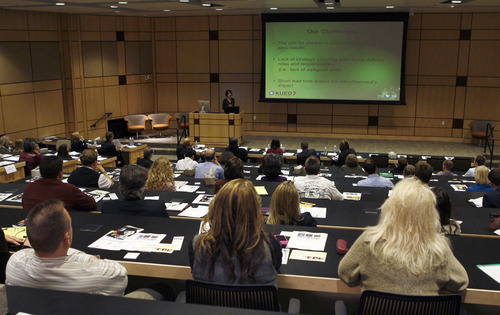This is an archived article that was published on sltrib.com in 2010, and information in the article may be outdated. It is provided only for personal research purposes and may not be reprinted.
West Jordan • Many Utah charities and other nonprofit groups are buckling under the weight of the Great Recession.
On Thursday, the Community Foundation of Utah helped present strategies designed to hone organizations' business acumen and attract more charitable giving.
Although demand for assistance has increased since the economic meltdown, charitable giving is down again this year, putting a third of the organizations in danger of closing their doors, according to a study by Wells Fargo and the Community Foundation.
"Utah's nonprofits know they need to develop innovative strategies and to re-examine their strategic plans to increase revenue and their value to the community," said Fraser Nelson, executive director of the foundation, which provides services and cash to other nonprofit groups.
Under a new program, the foundation matched the talents of 40 entrepreneurs and 12 graduate students with six nonprofit groups facing marketing or funding challenges. Each was given a $1,000 budget, six mentors and three months to develop solutions that other nonprofits can replicate or learn from, said Nelson.
An audience of more than 100 leaders from foundations, academia and the corporate and nonprofit sectors meeting at the Tanner Building Tuesday named the Salt Lake Head Start agency as coming up with the most innovative strategy.
The goal of the agency, which provides early education for low-income children, was to rebrand itself to increase funding from nongovernmental sources.
Head Start's comprehensive — and sometimes confusing — programs for children were condensed to three simple categories: health care, education and self-sufficiency tools to break the cycle of poverty.
Erin Trenbeath-Murray, director of Salt Lake Head Start, said the three categories are designed to appeal to different groups — education to parents and educators, treatment programs to medical professionals and self-sufficiency initiatives to the general community.
The agency's award-winning pamphlet described services for children. Among them were 394,690 nutritious meals served last year alone; 29,035 medical and dental screenings conducted; and academic gains made by 90 percent of enrolled children.
The six nonprofits in the program were selected from 30 to develop strategies. The other five were:
• The Utah Symphony and Opera, which showed how it is attracting new and younger audiences through its Vivace program for 20- to 40-somethings. It has grown during its five-year history to become the largest of its kind west of the Mississippi River.
• KUED public television, which unveiled a marketing campaign that uses social media to capture new viewers.
• Utah Partners for Health, which set new guidelines for providing health care to the underinsured in Salt Lake County.
• The Disability Law Center, which is trying to establish a sliding fee scale in its efforts to provide civil legal services for people with disabilities.
• The Spy Hop Production youth media arts and education center, which is looking at ways to increase earnings from existing programs.
Tuesday's session was the second in a series geared toward helping nonprofits survive challenges during the downturn. In December, 60 entrepreneurs conducted "speed mentoring" sessions.
Utah's nonprofits
A total of 5,500 registered charities and other nonprofit groups accounted for $5.3 billion in revenue and $7.8 billion in assets in 2008.
Three-quarters of nonprofits reported an increase in demand for 2009.
Donations declined by nearly a third in 2009 from the previous year, and so far this year half of all nonprofits lost a major funding source.
Source: Community Foundation of Utah





